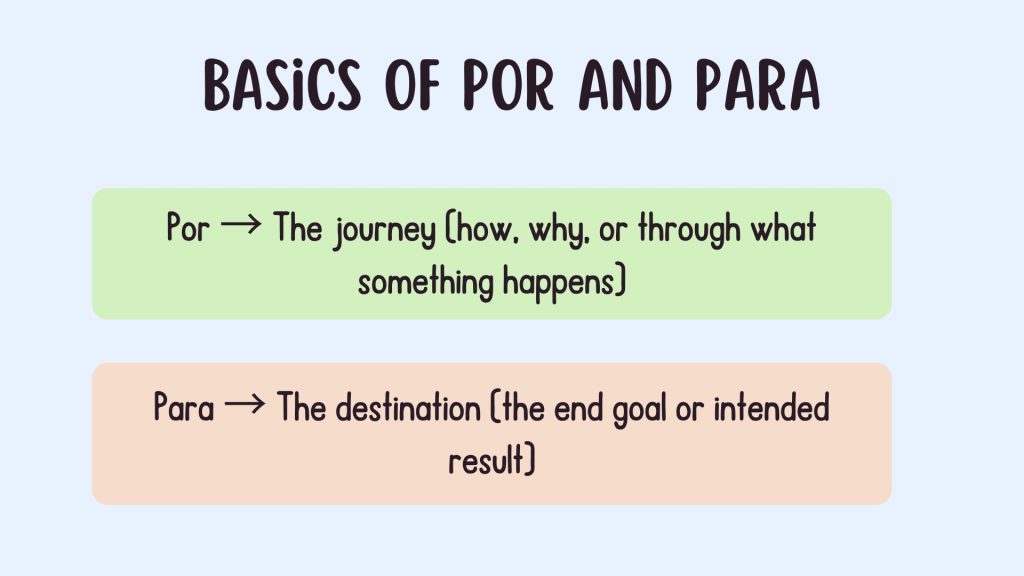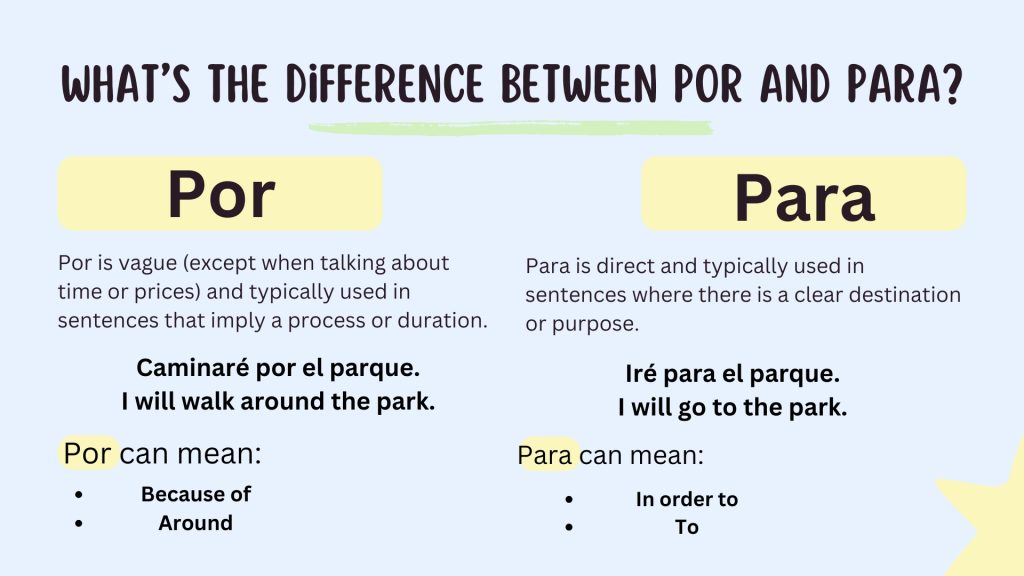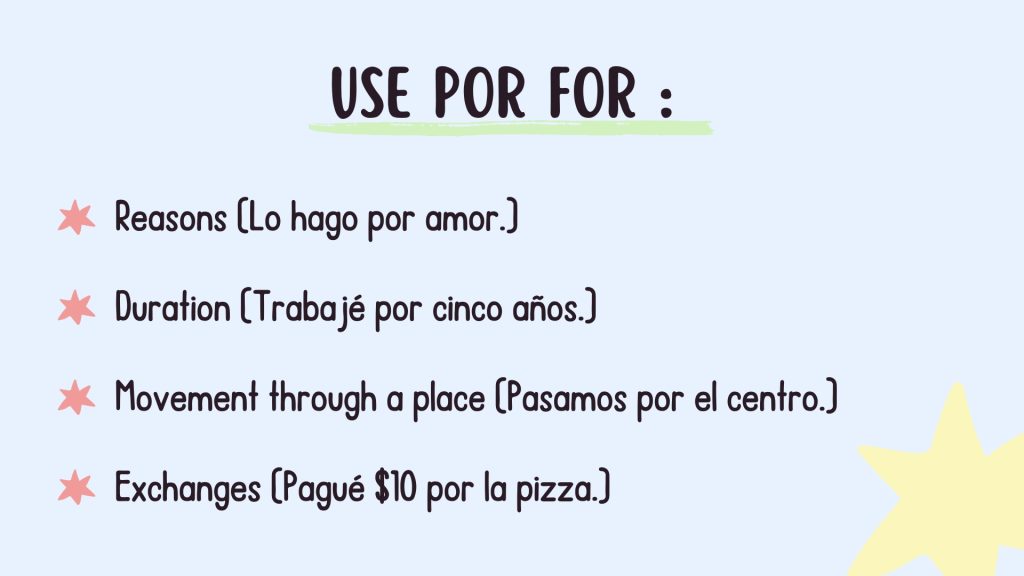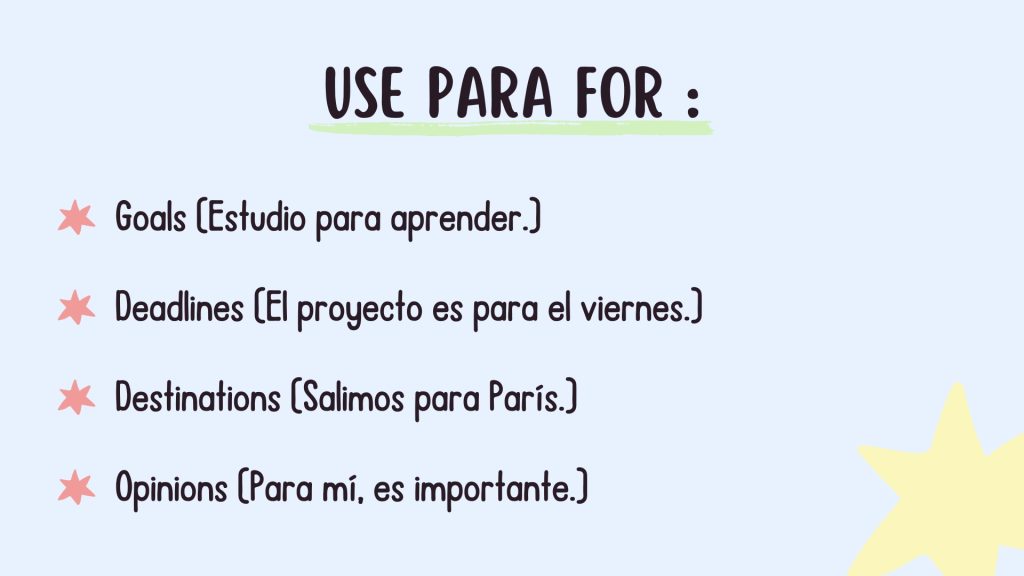In Spanish, the prepositions ‘por’ and ‘para’ are key to making your sentences clear and specific, but they can be tricky for learners because of their subtle differences. ‘Por’ is used to show reasons, exchanges, or time periods—it tells us why something is done. On the other hand, ‘para’ is used to show goals or destinations—it points to what we aim to achieve or where we’re headed.
Knowing how to use these prepositions correctly doesn’t just make your Spanish more accurate; it also helps you express complex ideas and intentions more clearly. Getting to grips with these differences is a big step towards mastering Spanish, and it opens up new ways to communicate fluently.
So, let’s dive deeper into how these prepositions work, shall we?
Understanding Por or Para in Spanish
Knowing when to use ‘por’ and ‘para’ is key to speaking Spanish well. They’re both often translated as ‘for,’ but they mean different things depending on the situation.
For example, ‘por’ can show why something happens, and ‘para’ can show what someone intends to achieve. They also differ when talking about time, where ‘por’ might express duration, like ‘for three hours,’ and ‘para’ could point to a deadline, like ‘by tomorrow.’
Getting them right really helps in making your meaning clear.
So, think of it this way: ‘por’ is a bit about reasons or causes — why things happen. On the other hand, ‘para’ is more about goals and deadlines — what you aim to do or when you need to do it by.
It’s a subtle but important difference, don’t you think?
The Basics of Por and Para
When you’re learning Spanish, understanding ‘Por’ and ‘Para’ is key. They look simple, but they actually do a lot to shape a sentence.
‘Por’ is usually about reasons or causes, like why something happens. It’s also about time periods and trading things.

‘Para’, on the other hand, is about goals, where something is headed, deadlines, or who something is for.
It’s pretty important to get these right, because mixing them up can change what you’re trying to say. So, it’s more than just grammar—it’s about making your point clear.
Think of por as related to movement, cause, or duration.
Think of para as focused on destination, purpose, or goals.
Here’s a quick way to remember:
- Por → The journey (how, why, or through what something happens)
- Para → The destination (the end goal or intended result)
Common Uses of Por in Spanish Grammar
Understanding how to use ‘por’ in Spanish is key to speaking the language well. ‘Por’ helps express reasons or causes. For example, you say ‘gracias por la ayuda’ when you mean ‘thanks for the help.’
It’s also used to talk about time duration, like in ‘estudié por dos horas,’ which means ‘I studied for two hours.’ Plus, it’s handy for talking about exchanges, such as ‘cambio dólares por euros’ or ‘exchange dollars for euros.’
| Use | Example | English Meaning |
|---|---|---|
| Reason or Cause | Lo hice por ti. | I did it because of you. |
| Duration of Time | Estudié por tres horas. | I studied for three hours. |
| Means or Method | Hablamos por teléfono. | We talked on the phone. |
| Movement Through a Place | Caminé por el parque. | I walked through the park. |
| Exchange or Substitution | Te doy $10 por el libro. | I’ll give you $10 for the book. |
| General Location | Hay muchas tiendas por aquí. | There are many stores around here. |
Common Uses of Para in Spanish Grammar
‘Por’ is used to talk about reasons or how long something lasts.
‘Para’, on the other hand, is generally used when talking about the purpose or end point of something in Spanish.
For example, if you want to say who something is intended for, you use ‘para’. Like when you say ‘Este regalo es para ti’ – that means ‘This gift is for you’.
Also, ‘para’ is used when you’re talking about deadlines. So, if you need something done by a certain time, like ‘Necesito el informe para el viernes’, you’re saying ‘I need the report by Friday’.
| Use | Example | English Meaning |
|---|---|---|
| Destination | Voy para Madrid. | I’m going to Madrid. |
| Recipient | Este regalo es para ti. | This gift is for you. |
| Purpose or Goal | Estudio para ser doctor. | I study to become a doctor. |
| Deadline | La tarea es para mañana. | The homework is due tomorrow. |
| Opinion | Para mí, es interesante. | For me, it’s interesting. |
| Comparison | Para su edad, corre rápido. | For his age, he runs fast. |
Discover the Most Romantic Spanish Terms of Endearment.
When to Use Por or Para
Choosing when to use ‘por’ or ‘para’ in Spanish can be tricky. Use ‘para’ when you’re talking about a destination, the purpose of something, or who something is intended for.
On the other hand, ‘por’ is used to talk about the duration of time something takes, the reason something happens, or the way something is done.
Getting this right makes your Spanish clearer and shows you really get the language.
Por vs Para: Key Differences and Uses
In Spanish, the prepositions ‘por’ and ‘para’ look alike but they do different jobs. Think of ‘por’ as the preposition that explains why something happens. It talks about reasons or duration, like saying ‘I did it for you’ or ‘I traveled by train.’

On the other hand, ‘para’ is about goals or endpoints. It helps us tell what something is intended for or when something needs to be done. For example, ‘this gift is for Mom’ or ‘this needs to be finished by Friday.’
| Por | Para |
|---|---|
| Cause or reason | Purpose or goal |
| Duration of time | Deadline |
| Method or means | Destination |
| Movement through a place | Movement toward a place |
| Exchange | Recipient |
Common Reflexive Verbs in Spanish You Need to Know
Por vs Para Rules Explained
Grasping the use of ‘por’ and ‘para’ is key to getting better at Spanish.
This part will break down the main rules that help you know when to use each preposition.
✅ Use por when talking about the reason, process, or journey.
✅ Use para when talking about the final goal, recipient, or deadline.
Breaking Down the Rules of Por vs Para
There are some clear rules to follow when deciding between ‘por’ and ‘para’ in Spanish. Think of ‘por’ as explaining why something happens or how you do something. For example, you might use ‘por’ to talk about why you’re taking a trip or how you’re traveling. On the other hand, ‘para’ is more about what you aim to achieve or where you’re going. It helps make clear what your goal is or where your final stop is.
These distinctions might seem small, but they really help in making your meaning clear. It’s like showing whether you’re talking about the reason behind something or what you’re trying to achieve. By choosing ‘por’ or ‘para’ carefully, you make your conversation clearer.
If you only remember one thing, let it be this:
- Por = how and why something happens
- Para = where it’s going or what it’s for
Imagine por as the road and para as the destination.
Example:
- Voy a viajar por Francia para visitar a mi familia.
(I’m traveling through France because of my family.)
One word can change the meaning completely:
- Trabajo por mi familia. (I work because of my family.)
- Trabajo para mi familia. (I work for my family.)
Essential Rules for Using Por and Para Correctly
To get the hang of using ‘por’ and ‘para’ in Spanish, just remember a couple of key points. Think of ‘por’ when you’re talking about reasons something happens, how long it lasts, or what you might trade for something else.
On the other hand, use ‘para’ when you’re talking about where something is headed, who it’s for, when it needs to be done, or why you’re doing it.
Keeping these tips in mind will help you communicate more clearly and effectively in both written and spoken Spanish.
Here’s a final cheat sheet to help you:
🟢 Use POR for:

- Reasons (Lo hago por amor.)
- Duration (Trabajé por cinco años.)
- Methods (Te llamé por teléfono.)
- Movement through a place (Pasamos por el centro.)
- Exchanges (Pagué $10 por la pizza.)
🔵 Use PARA for:

- Goals (Estudio para aprender.)
- Deadlines (El proyecto es para el viernes.)
- Destinations (Salimos para París.)
- Recipients (Esto es para ti.)
- Opinions (Para mí, es importante.)
Conclusion
Understanding ‘por’ and ‘para’ is key for clear and precise Spanish. ‘Por’ is about reasons, methods, and times.
‘Para’ focuses on purposes, goals, and endpoints. Knowing the difference makes your Spanish better and your expressions more nuanced.
So, it’s a good idea to really dig into how these prepositions work in different situations to get your point across more clearly.
Master English Grammar – Join Lingua Viva Today!
Carolina is a charming and lively member of Lingua Viva with 11+ years of teaching experience. She loves to teach students appropriate ways to communicate effectively in Spanish without the fear of making mistakes. She holds a professional teaching license and has a graduate degree with emphasis in Foreign Language.











